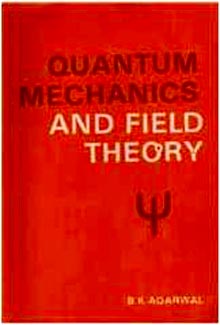
 The Artist
The Artist
Important Dates
Born On: 2nd April, 1931; Fatehpur(U.P.)
1952: M.Sc. Physics, University of Allahabad
1956: Head of Department of Physics, University of Allahabad
1990: Bhuvaneshwar Award
Died On: 8th July, 1989; America



Quantum Mechanics And Field Theory
|
Quantum Mechanics is now the language of all physics. This book is specially designed to introduce the basic elements of the subject in a simple and convincing way. The essential underlying principles are clearly formulated and applied to specific examples to bring out their strength and scope. The first eight chapters deal with the nonrelativistic quantum mechanics. The main emphasis is on the physical ideas and mathematical formalism associated with them. The treatment of topics like eigenvalue problems, perturbation theory, many-electron systems and scattering is straightforward and self-sufficient. Inspite of the inherent difficulty of the subject, these chapters make only modest demands on the background of beginning students. |
|
 |
The next two chapters deal with one particle relativistic quantum mechanics and electromagnetic events like photoelectric effect and Compton effect. The powerful method of second quantization is developed in the last twelve chapters. The theory behind the Feynman graphs is completely worked out and then applied to interacting fields involving electromagnetic, weak and strong interactions. Modern topics like dispersion relations and Regge poles are introduced in the context of particle physics. This is a unique introductory book on Quantum Mechanics which covers the entire range of the subject from the historical beginning to the latest developments. |

Statical Mathematics
|
This book gives a clear and logical exposition of the basic method of ensembles in Statistical Mechanics as developed by J. W. Gibbs. Beginning with the Liouville theorem, a brief but useful introduction to the classical statistical mechanics is provided. Then the quantum picture is outlined and basic postulates of quantum statistical mechanics are stated. The discussion of the symmetry of wave function and its effect on counting is given in detail. The relation between statistical mechanics and thermodynamics is worked out and the Gibbs paradox is discussed in a lucid way. The concept of entropy is related to the information theory. Various ensembles are constructed and used to derive the Bose- Einstein and Fermi- Dirac distributions. Planck's law is obtained with applications to MASER and LASER. A full chapter is devoted to partition functions. |
|
|
Detailed presentation is given to the degeneracy of the Bose- Einstein and Fermi- Dirac ideal gases. Topics like liquid He, electrons in metals and white dwarfs are given adequate coverage. Quantum Hall effect, random walk and Fourier analysis of a random fluctuation are devoted sufficient space to make it a useful and fascinating book. The book concludes with a discussion of the lsing model and a modern treatment of the critical phenomena. Problems in the end of each chapter widen the area covered and also help to deepen the understanding of the material given. This book is written to introduce the subject to advance undergraduates in physics and chemistry or to graduates in engineering classes. |

|

X-Ray Spectroscopy
 |
X-Ray Spectroscopy conveniently presents the principles, applications and current techniques of this powerful tool. It is an ideal textbook for students beginning research involving X-ray spectroscopy, which has found numerous applications in the study of metals, semiconductors, amorphous solids, liquids and gases. The second edition includes topics that have recently become important, for example, the X-ray laser, appearance potential spectroscopy and synchrotron radiation. A major addition is a thorough introduction to EXAFS. |

Thermal Physics
|
This is a simple but accurate book on the difficult subject of Heat and Thermodynamics. Attempt has been made to remove some of the misconceptions that usually creep on while studying this subject. The book should be helpful to those who like to teach this subject to impart not only the information but at a deeper pedagogical level to convey the underlying ideas as well. The latter is necessary because the laws of thermodynamics have a wider significance than the immediate context in which they are formulated. |
|
|
The book introduces the concept of Temperature through the Zeroth Law of Thermodynamics. The difference between point functions and path functions is clearly explained. The kinetic theory is developed and employee to estimate the varios parametres occurring in the equations applicable to macroscopic systems. The chapter on Radiation deals in an unambiguous fashion with the edeas of Planck and the quantum distribution law for the blackbody radiation is derived in a systematic way. It is hoped that the book will be useful both to the teachers and the students who enjoy studying this subject. |

|

Nuclear Physics
 |
The world of atoms and nuclei, while not directly accessible to, or perceived by our senses, is of fundamental importance in understanding the physics which has changed the shape od the world in this century. Thus the subject of Nuclear Physics is both a difficult one and at the same time of great importance to the student of physics. Therefore, it is of utmost importance that his grasp of the concepts involved is sound so that he can also follow the developments which have made this century such an exciting era of discoveries for the physicist.
In this book the subject matter has been presented in a simple yet comprehensive manner so that a student, who is new to the field, can understand clearly the concepts involved. |
 Home
Home Introduction
Introduction The Writer
The Writer The Scientist
The Scientist Painting Exhibitions
Painting Exhibitions